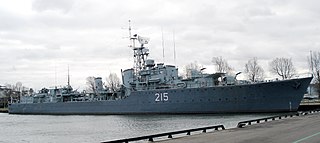
HMCS Haida is a Tribal-class destroyer that served in the Royal Canadian Navy (RCN) from 1943 to 1963, participating in World War II and the Korean War. She was named after the Haida people.

HMS Arab was a B-class torpedo boat destroyer of the British Royal Navy. She was laid down by J & G Thomson at Clydebank and completed by John Brown & Company who took over the yard.

The C and D class was a group of 14 destroyers built for the Royal Navy in the early 1930s. As in previous years, it was originally intended to order a complete flotilla comprising eight destroyers—plus a flotilla leader as the ninth unit—in each year. However, only four ships—plus a leader—were ordered under the 1929–1930 Programme as the C class. The other four ships planned for the C class were never ordered as an economy measure and disarmament gesture by the Labour government of Ramsay MacDonald. A complete flotilla—the 'D' class—was ordered under the 1930–1931 Programme.

HMS Ithuriel was a Marksman-class flotilla leader of the British Royal Navy. Originally to have been named Gabriel, the name was changed before her launch. The ship was built by Cammell Laird at Birkenhead, being launched on 8 March 1916 and entering service in August that year. Ithuriel served with the Grand Fleet during the First World War, leading both a destroyer flotilla and a submarine flotilla. She survived the war, before being sold for scrap on 8 November 1921.

The S class was a class of 67 destroyers ordered for the Royal Navy in 1917 under the 11th and 12th Emergency War Programmes. They saw active service in the last months of the First World War and in the Russian and Irish Civil Wars during the early 1920s. Most were relegated to the reserve by the mid-1920s and subsequently scrapped under the terms of the London Naval Treaty. Eleven survivors saw much action during the Second World War.

HMS Patrician was a Thornycroft M-class destroyer that served in the British Royal Navy during World War I. The destroyer entered service in 1916 and served with the Grand Fleet. Following the war, the destroyer was deemed surplus and she was transferred to the Royal Canadian Navy in 1920 and served there until 1928. She was sold for scrap in 1929.

The Active-class cruisers were a trio of scout cruisers built for the Royal Navy shortly before the First World War. They were initially assigned to the First Fleet and became destroyer flotilla leaders in 1914. Amphion and Fearless and their flotillas were assigned to the Harwich Force when the war began in August 1914. They went out on a patrol on the first day of the war and Amphion and her destroyers encountered and sank a German minelayer. On the voyage home, the cruiser struck a mine laid by the German ship and sank. She was the first ship of the Royal Navy to be sunk in the war.
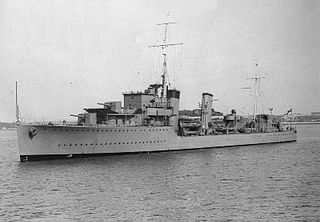
HMS Kempenfelt was a C-class destroyer built for the Royal Navy in the early 1930s. A flotilla leader, she saw service in the Home Fleet before World War II and the ship made several deployments to Spanish waters during the Spanish Civil War, enforcing the arms blockade imposed by Britain and France on both sides of the conflict.

HMS Acheron was the name ship of the Acheron-class destroyer of the British Royal Navy. She is named after the River Acheron, believed in Greek Mythology to be a branch of the River Styx. She was the fifth ship of the Royal Navy to bear the name.
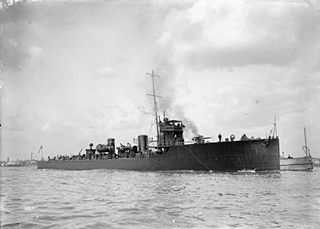
HMS Ariel was an Acheron-class destroyer built in 1911, which served during the First World War and sank in 1918 after striking a mine. Named after Shakespeare's "airy spirit", or the biblical spirit of the same name, she was the tenth and last ship of the name to serve in the Royal Navy.

HMS Porpoise was an Acasta-class destroyer of the Royal Navy, which was built by Thornycroft between 1912 and 1914. Porpoise served through the First World War, taking part at the Battle of Jutland in 1916, where she was damaged. In 1920, she was sold to the Brazilian Navy serving under the name Alexandrino de Alencar and was renamed Maranhão in 1927. Maranhão remained in service when Brazil entered the Second World War, being used for patrol and convoy duties. She was disposed of in 1945.
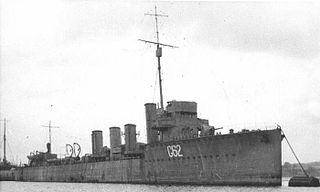
HMS Marksman was a Marksman-class flotilla leader of the British Royal Navy. Construction at Hawthorn Leslie's Newcastle upon Tyne shipyard began in 1914, shortly before the outbreak of the First World War, and the ship was launched and completed in 1915. She took part in the Battle of Jutland in 1916 and survived the war. She was sold for scrap in 1921.

HMS Rosalind was an R-class destroyer which served with the Royal Navy. The ship was launched by Thornycroft on 14 October 1916 as the first of five similar ships ordered from the yard. The design was used as the basis for five subsequent ships of the S-class also built by the company. Rosalind served as part of the Grand Fleet during the First World War, operating as an escort to other warships and in anti-submarine patrols alongside other destroyers. The vessel was sold to be broken up on 13 July 1926.

HMS Rob Roy was a Royal Navy R-class destroyer constructed and then operational in the First World War. The ship served in the Grand Fleet as part of the Fifteenth Destroyer Flotilla.

HMS Landrail was a Laforey-class destroyer of the British Royal Navy. The Laforey class was the class of destroyers ordered under the Royal Navy's 1912–1913 construction programme, which were armed with three 4-inch (102 mm) guns and four torpedo tubes and were capable of 29 knots. The ship, which was originally to be named Hotspur but was renamed before launch, was built by the Scottish shipbuilder Yarrow between 1912 and 1914,
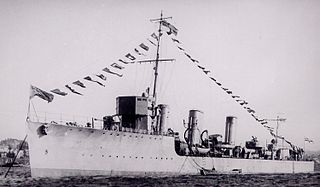
HMS Rapid was a destroyer of the M class that served with the Royal Navy during First World War. Launched by Thornycroft in 1916, the vessel was the one of two similar ships ordered as part of the Fifth War Construction Programme. They differed from the remainder of the M class in having more powerful engines. The design was used as the basis for the subsequent five ships of the R-class also built by the yard. Rapid served in escort and patrol roles, principally providing defence from submarines as part of the Grand Fleet until it was disbanded at the end of the War. After the end of hostilities, the vessel served in minor roles, including briefly as part of the Admiralty Compass Department in 1921 and 1924, but was sold to be scrapped in 1927.
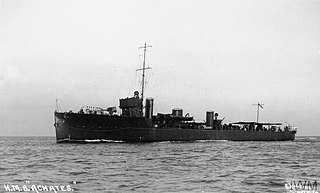
HMS Achates was an Acasta -class destroyer of the British Royal Navy. She was built by the Scottish shipbuilder John Brown and was built between 1912 and 1913. Like all Acasta-class destroyers, Achates was armed with three 4-inch (102 mm) guns and two torpedo tubes, with a specified speed of 29 knots.

HMS Peregrine was a Admiralty M-class destroyer that served with the Royal Navy during the First World War. The M class were an improvement on the preceding L class, capable of higher speed. Launched on 29 May 1916, the vessel served with the Grand Fleet, focusing on anti-submarine warfare. In 1917, the destroyer was involved in the search for UC-65 after the submarine had sunk the protected cruiser Ariadne. In 1918, the ship participated in one of the final sorties of the war, although this did not lead to a confrontation with the German High Seas Fleet. After the Armistice that ended the war, the destroyer was placed in reserve and subsequently sold to be broken up on 9 May 1921.
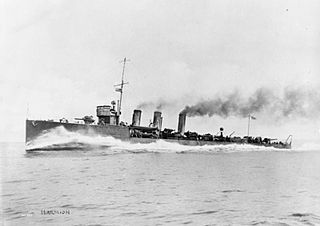
HMS Mons was an Admiralty M-class destroyer which served with the Royal Navy during the First World War and fought in the Battle of Jutland. The M class was an improvement on the preceding L class, capable of higher speeds. The ship, the first British naval vessel to be named after the Battle of Mons, was launched in 1915. Joining the Grand Fleet as part of the new Eleventh Destroyer Flotilla, the destroyer was soon in action, taking part in patrols that aimed to draw out the German High Seas Fleet. During the Battle of Jutland in 1916, Mons attacked the German light cruisers at the forefront of the German battleline but scored no hits. After the armistice, the destroyer was placed in reserve. Mons was found to be worn out by wartime operations and, despite only serving for six years, in 1921, was sold to be broken up.

HMS Oracle was a Repeat Admiralty M-class destroyer which served in the Royal Navy during the First World War. The M class were an improvement on the previous L-class, capable of higher speed. The vessel was launched on 23 December 1915 and joined the Grand Fleet. Oracle spent much of the war involved in anti-submarine warfare. In August 1916, the destroyer rescued the crew of the light cruiser Nottingham, which had been sunk by a German submarine. In August 1917, the destroyer rammed and sank the submarine U-44. After the Armistice that marked the end of the First World War, the destroyer was transferred to Portsmouth. Initially, the destroyer was part of the local defence flotilla but soon Oracle was placed in reserve, decommissioned and, on 30 October 1921, sold to be broken up.




















